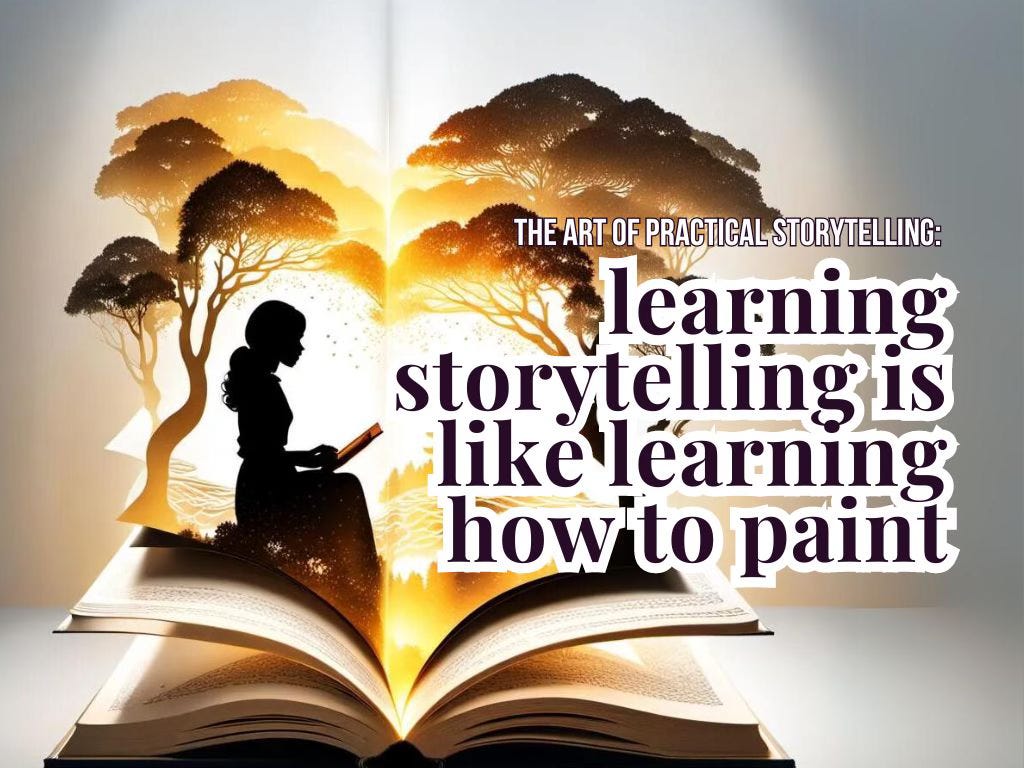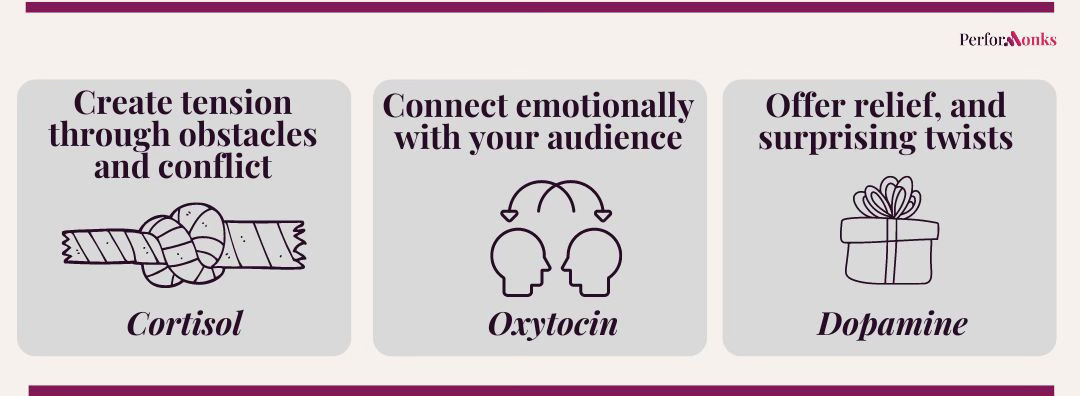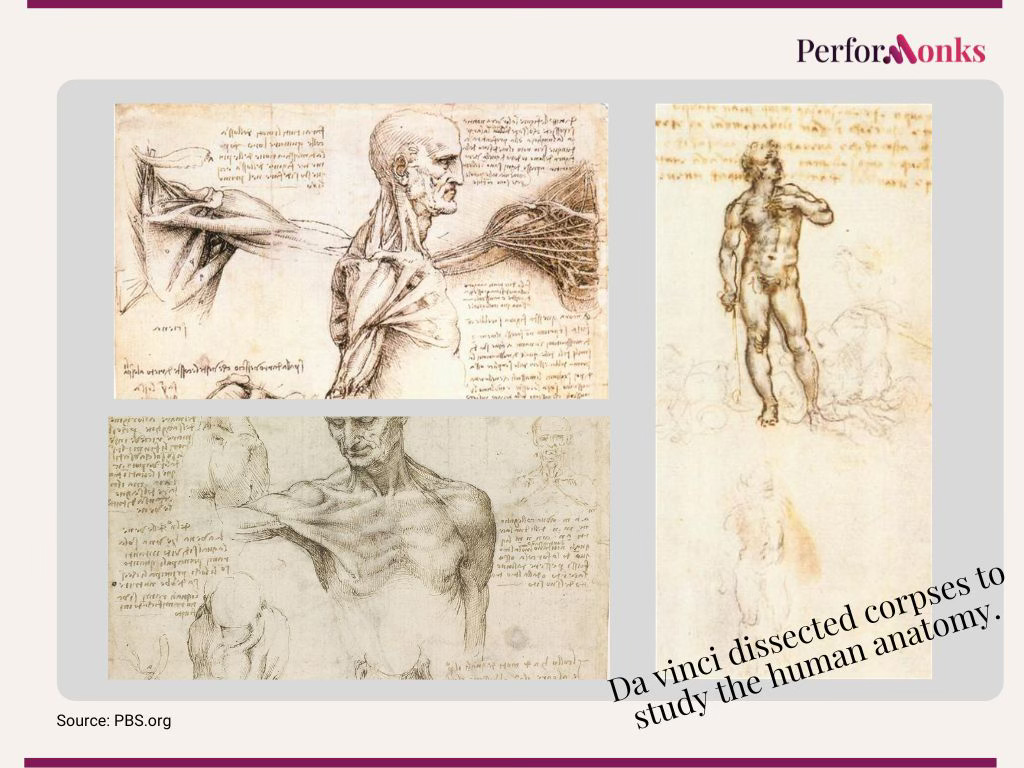The art of practical storytelling: learning storytelling is like learning how to paint
Like painting, storytelling mastery demands structure, taste and practice
Practical ideas on how to master brand strategy. Performonks goes to 4,081 curious marketers and founders - join them here. Find The India Playbook here.
Welcome to Part 3 of The Art of Practical Storytelling series.
Part 1 focused on the foundational rule - Prioritize stories over facts.
In Part 2, we looked under the hood of the human brain to understand that good stories activate chemical reactions in our brains— the dopamine-cortisol-oxytocin cocktail changes people's minds.
Today, I compare learning to paint to learning storytelling. I also give a sneak preview of the seven universal storytelling plots.
What we know until now can be encapsulated in a simple equation.
Like any art form, this equation is easy to understand but difficult to practice.
I guess that’s why is series is called ‘The Art of Practical Storytelling’. Let’s take a sgue into this for a moment.
Why Practical. Why Storytelling. Why Art.
Storytelling - people think that storytelling is what advertising folks do and that only big-budget Marvel movies are stories. Wrong. If stories are how our brain makes sense of the world, then everything we say, hear, and write is a story.
Practical—I want to learn and simultaneously share how to apply storytelling concepts to all types of marketing and everyday situations.
Art - storytelling is not e=mc2. The same strategy might succeed in one situation but fail miserably in another.
That’s why storytelling is an art form. Like painting.
Like painting, storytelling mastery demands structure, taste and practice.
Simply owning the best paints and paintbrushes doesn’t make someone a painter. To master their art, artists religiously do three things.
One, they learn the foundational structure.
Frameworks and mental models govern good painting—what type of paint goes on what canvas, how to mix colours, what kind of paper and pencils create what kind of art, guache vs. watercolour techniques, etc.
That good stories activate a chemical cocktail in the brain, is one such framework.
Today, we will get a sneak preview of a second framework - Seven universal plots. The framework says all stories, bar none, follow seven universal plots. More on that later.
Just as many rainforests' worth of literature come from just 26 alphabets, these seven plots are limited only by our imagination.
While all seven plots follow different story structures, all of them activate the same chemical cocktail-
They create tension through obstacles and conflict.
They connect emotionally with the audience.
They offer relief and surprises.
So, instead of spending hours in mental contortions, mapping words to oxytocin et all, we can pour our story into one of these seven plots and watch it come to life.
Two, they develop their taste
They consume large quantities of art—by the greats and the not-so-greats. They observe how colours change in different lights, how rivers catch the sunlight, or how muscles move in the body (remember Da Vinci’s obsession with corpses?)
How do we develop our taste as storytellers?
I urge all of you to keep a swipe file.
Sign up for Evernote or Notion (both are free). At first, even a Word doc will do.
Start collecting stories, pictures, ads, snippets, and dialogues you like.
Make this your first swipe file entry.
Finally, start observing folks at work, at home, or in media whose storytelling you find persuasive and inspiring. Note: pick your role models with care because God-like persuasive impact declines rapidly without corporate decorations :-).
Three, they practice a lot.
They start by copying heroes ( heroines) they admire. They practise and practise and practise until one day, they discover their voice.
Sometimes you have to play a long time to be able to play like yourself.
- Miles Davis
Once you start to pay attention, you will see stories everywhere.
This is a section from the site I was reading to understand Da Vinci’s experiments with corpses.

And this is something a girl said to me in a consumer group many years ago that I will never forget.
I believe that practical storytelling is a critical life skill and should be taught in all schools and colleges.
If I were to teach this, I would stand on the shoulders of giants like Christopher Booker.
After researching stories for 34 years(!), Christopher Booker concluded that all storytellers - from Shakespeare to Murakami, from Ramayana to Panchtantra - follow only seven basic plots.
1. Overcoming the Monster: conquering seemingly insurmountable challenges.
2. Rags to Riches: humble beginnings transformed into riches beyond imagination.
3. The Quest: a journey to achieve a mission or goal.
4. Voyage and Return: a risky adventure from which we return enriched and matured.
5. Comedy: misunderstandings and laughter that finally lead to transformation.
6. Tragedy: human suffering that ultimately leads to catharsis and personal growth. This may not have a happy ending.
7. The Rebirth: a personal transformation that leads to good outcomes.
I had mentioned earlier that we can tell a story even on a post-it. But I guess there are exceptions to all rules. I tried and tried but could not convert this Post-it into a persuasive story.
Any suggestions?
Next week, we will explore one story plot with examples from advertising, of course, but also from practical everyday situations.
Thanks for reading!









